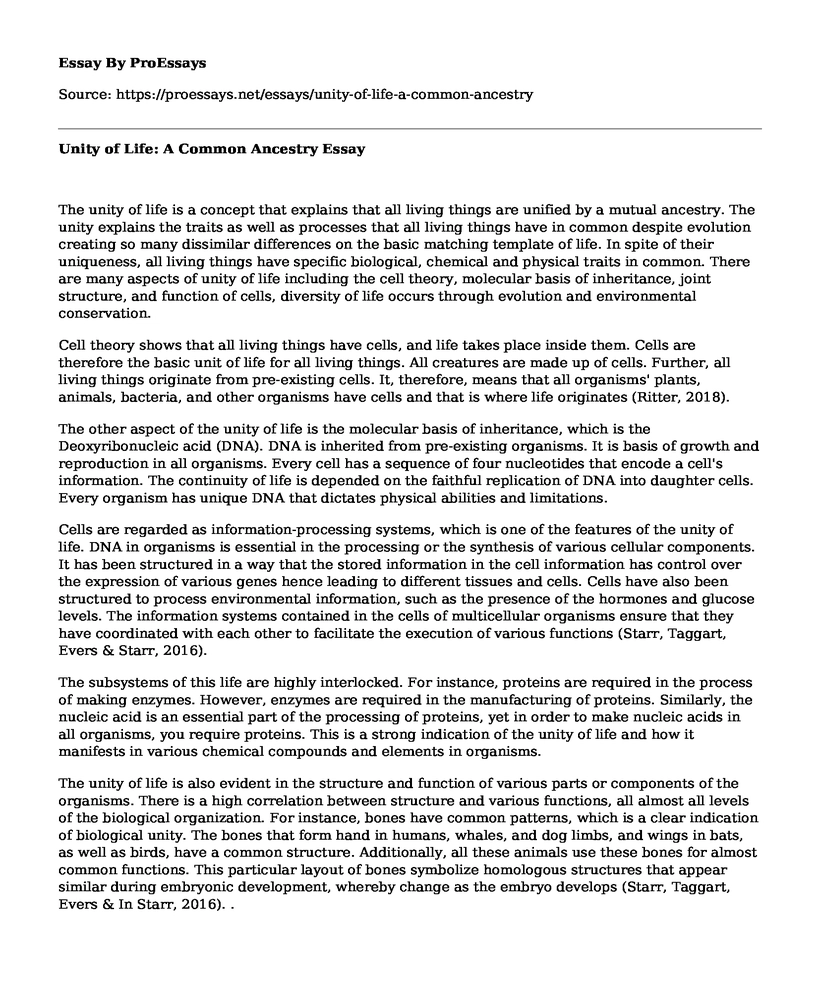The unity of life is a concept that explains that all living things are unified by a mutual ancestry. The unity explains the traits as well as processes that all living things have in common despite evolution creating so many dissimilar differences on the basic matching template of life. In spite of their uniqueness, all living things have specific biological, chemical and physical traits in common. There are many aspects of unity of life including the cell theory, molecular basis of inheritance, joint structure, and function of cells, diversity of life occurs through evolution and environmental conservation.
Cell theory shows that all living things have cells, and life takes place inside them. Cells are therefore the basic unit of life for all living things. All creatures are made up of cells. Further, all living things originate from pre-existing cells. It, therefore, means that all organisms' plants, animals, bacteria, and other organisms have cells and that is where life originates (Ritter, 2018).
The other aspect of the unity of life is the molecular basis of inheritance, which is the Deoxyribonucleic acid (DNA). DNA is inherited from pre-existing organisms. It is basis of growth and reproduction in all organisms. Every cell has a sequence of four nucleotides that encode a cell's information. The continuity of life is depended on the faithful replication of DNA into daughter cells. Every organism has unique DNA that dictates physical abilities and limitations.
Cells are regarded as information-processing systems, which is one of the features of the unity of life. DNA in organisms is essential in the processing or the synthesis of various cellular components. It has been structured in a way that the stored information in the cell information has control over the expression of various genes hence leading to different tissues and cells. Cells have also been structured to process environmental information, such as the presence of the hormones and glucose levels. The information systems contained in the cells of multicellular organisms ensure that they have coordinated with each other to facilitate the execution of various functions (Starr, Taggart, Evers & Starr, 2016).
The subsystems of this life are highly interlocked. For instance, proteins are required in the process of making enzymes. However, enzymes are required in the manufacturing of proteins. Similarly, the nucleic acid is an essential part of the processing of proteins, yet in order to make nucleic acids in all organisms, you require proteins. This is a strong indication of the unity of life and how it manifests in various chemical compounds and elements in organisms.
The unity of life is also evident in the structure and function of various parts or components of the organisms. There is a high correlation between structure and various functions, all almost all levels of the biological organization. For instance, bones have common patterns, which is a clear indication of biological unity. The bones that form hand in humans, whales, and dog limbs, and wings in bats, as well as birds, have a common structure. Additionally, all these animals use these bones for almost common functions. This particular layout of bones symbolize homologous structures that appear similar during embryonic development, whereby change as the embryo develops (Starr, Taggart, Evers & In Starr, 2016). .
In conclusion, the unity of life describes the things that organisms have in common. They have cells, which are the basic unit of life, DNA which is unique to every organism, diversity of experience, evolutionary conservation and structure and function of every living thing. In spite of the uniqueness of living things, they have something that they share.
References
Ritter, W. E. (2018). The unity of the organism ; or, The organismal conception of life, v. 02. Place of publication not identified: Boston, R.G. Badger.
Starr, C., In Taggart, R., In Evers, C. A., & In Starr, L. (2016). Biology: The unity and diversity of life. Australia : Cengage Learning
Cite this page
Unity of Life: A Common Ancestry. (2023, Feb 23). Retrieved from https://proessays.net/essays/unity-of-life-a-common-ancestry
If you are the original author of this essay and no longer wish to have it published on the ProEssays website, please click below to request its removal:
- Research Paper Sample on Economies of Scale and Scope
- Media Analysis Presentation Example
- Consumer Health Issues Essay
- Problems Experienced by St. George Nursing Home Paper Example
- Careless Use of Resources Can Deplete Them - Essay Sample
- Essay Sample on Death's Reality: Emily Dickinson's Reflection on Life and Beyond
- The Rise of Trade Capitalism: 1700-WWI - Essay Sample







